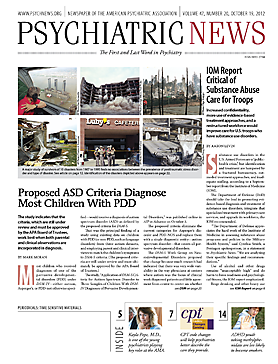An enzyme in the machinery of epigenetics links two neurochemical signaling systems in the brain that are important contributors to schizophrenia. The findings provide potential targets for new, better drug therapy for the disorder.
The study, by Mitsumasa Kurita, Ph.D., of the Department of Psychiatry at Mount Sinai School of Medicine and colleagues, was published online in Nature Neuroscience on August 5. It demonstrated how long-term use of second-generation antipsychotics, also known as atypical antipsychotics, can trigger molecular changes that make the treatment less effective.
The study demonstrates that a series of changes in the brain take place after chronic use of atypical antipsychotics involving three key players: serotonin 5HT2A receptor, metabotropic glutamate 2 receptor (mGlu2), and histones.
The 5HT2A receptor plays an important role in the pathology of schizophrenia. For example, atypical antipsychotics such as clozapine and risperidone are antagonists to 5HT2A and, in chronic use, cause its down-regulation. Conversely, 5HT2A agonists such as lysergic acid diethylamide (LSD), psilocybin, and mescaline are known to induce hallucinations and other psychotic symptoms.
The role of metabotropic glutamate 2 and 3 (mGlu2/3) receptors in schizophrenia has only recently been identified in animal and human research, and drugs that activate the mGlu2/3 receptors showed possible efficacy in treating schizophrenia in animal models.
In a phase 2 clinical trial published in the October 2007 Nature Medicine, a mGlu2/3 receptor agonist reduced positive and negative symptoms in schizophrenia patients.
Histones are protein spools for DNA strands to wrap around when they are not replicating. Histone acetylation is one of the fundamental epigenetic “switches.” For example, adding an acetyl group to histone slightly changes the local wrapping of a DNA strand and allows the gene on the DNA strand to be transcribed into mRNA, or turned “on.” Conversely, histone deacetylation can turn a gene off.
In this study, researchers found that chronic use of atypical antipsychotics decreased the density of 5HT2A in the frontal cortex in mice. Subsequently, an enzyme known as histone deacetylase 2 (HDAC2) is increased in the same brain region. HDAC2 causes a histone modification that blocks the mGlu2 gene from transcription, effectively turning the gene off. Subsequently, the production of mGlu2 receptor was suppressed. The mGlu3 receptor is not affected by this process.
The researchers were able to prove this sequence of events by showing that in mice with the 5HT2A gene knocked out, chronic administration of atypical antipsychotics could not induce the same effects on HDAC2 or mGlu2. Haloperidol, which acts predominantly on the dopamine D2 receptor, also had no effect on HDAC2 or mGlu2.
These findings in mice were duplicated in humans. The authors compared postmortem frontal cortex tissues from patients with schizophrenia who had been treated long term with atypical antipsychotics and patients who had had no antipsychotic treatment. The data showed that atypical antipsychotic use was associated with higher levels of HDAC2 in the frontal cortex.
“This down-regulation of mGlu2 may explain some of the limited effectiveness of clozapine,” Javier Gonzalez-Maeso, Ph.D., told Psychiatric News. He is an assistant professor of psychiatry and neurology at Mount Sinai School of Medicine and the lead investigator of the study. In the study, having too much HDAC2 in mouse brain, delivered by a virus containing the gene, also reduced mGlu2 expression and induced behavioral effects equivalent to psychosis and cognitive impairments in humans with schizophrenia.
The researchers suggested that HDAC inhibitors may prevent the diminishing efficacy of atypical antipsychotics. For example, valproic acid is a nonspecific HDAC inhibitor, and some animal and human data indicate it may be an effective adjunct to chronic use of atypical antipsychotics.
To prove this point, the researchers injected an HDAC inhibitor known as SAHA in mice and saw a reversal of the clozapine-induced mGlu2 gene repression. Moreover, the effect of the HDAC inhibitor was translated into behavioral findings and augmented the effect of chronic clozapine in mice.
These findings could support research on new drugs that act on the mGlu2 receptor. “We showed schizophrenia-like behavior in mice with lower mGlu2 receptor in frontal cortex; this further supports mGlu2 as a new antipsychotic drug target,” according to Gonzalez-Maeso.
Notably, Eli Lilly (which did not fund this study) has conducted several clinical trials on pomaglumetad methionil, an agonist of mGlu2/3 receptors, for the treatment of schizophrenia. In animal studies and early clinical trials, the drug showed promising efficacy without the adverse effects commonly seen with other antipsychotics. However, in July 2012, the company announced disappointing efficacy results from a large clinical trial, in which the mGlu2/3 receptor agonist failed to beat placebo in efficacy (
Psychiatric News, September 7).


